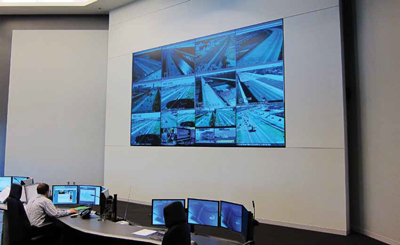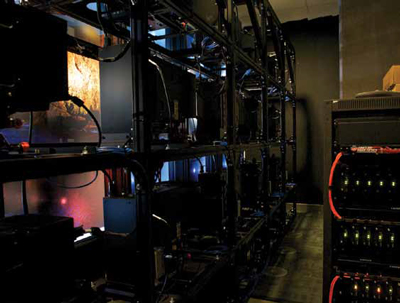Video Wall Processor and Cube Makers Predict the Future of Network Operation Centers

- Taking the temperature of the command and control space is a little like checking up on a college-bound teenager: there is a larger geographic area to cover, and more information to process when they take on more responsibility.
The Louisiana DOT’s video wall is comprised of 12 Mitsubishi Seventy Series rear-projection display monitors.
From the perspective of video wall processor and cube manufacturers, the command and control space continues to offer both stable and lucrative opportunities for systems contractors. This critical vertical market closely follows many of the major industry trends seen in other AV applications: the benefits of fiber transport are being deployed; users demand the ability to share content across various devices with remote (IP) access; collaborative, interactive environments are emerging; and retrofitting aging facilities is an important improvement for buildings and a valuable revenue stream for integrators.
See how representatives from some of the top manufacturers foresee these somewhat standard trends materializing in for operation centers over the next five years.
Struggling budgets will continue to dictate the market with the biggest challenges coming from federal and local government budgets. Nevertheless, there are a lot of antiquated control rooms in need of upgrading: it’s a necessity with the expanded use of processing information and the need for better display technologies. The biggest changes are the move to fiber solutions, the IP transition, and net-centric solutions. Processing changes and upgrades will be centered around the ability to move information to different areas. Instead of keeping everything in the room and displaying to a videowall, people now want to distribute information throughout the facility and worldwide. Cubes will still be the most desirable display technology, but flat panels have gained popularity due to budget issues. Projection is also becoming more prevalent for budgetary reasons: It’s easier and more flexible than cube technology.
—Richard Dussaigne, Senior Sales Consultant, Electrosonic

A Jupiter Systems Fusion Catalyst 4000 display wall processor that powers a video wall at the University of Calgary’s Taylor
Family Digital Library.For the next five years, I believe that we will see more focus on sub-markets within the control room space. The baseline technology may be the same, however we’ll have specialized features to better tailor solutions to our customer’s needs. For example, there will be more products designed for a control category and sub-categories, and in fact, it’s already happening. For instance, we have created the Thinklogical/Mitsubishi fiber optic solution for secure environments within the DoD/Intel community, because fiber is better suited for secure communications. We also see a focus on key security requirements within the electric utility space.
—Matt Krstulja, Director of Sales, Datawall, Mitsubishi Electric Visual Solutions America
We see expansion in command and control opportunities as more types of businesses bring large data sets and better visualization tools to a wider variety of business processes beyond traditional command and control applications, such as energy distribution or highway monitoring. In these control room environments, we are seeing an emphasis on digital high-resolution sources, higher pixeldensity displays, and more interactivity and control between decision makers and visual information.
—Steve Seminario, Senior Director of Product Marketing, Planar Systems
Today’s dispersed teams and global workforce require products that allow users to share video and captured desktop streams from any source on the traditional display wall—video, data, application screens—with colleagues anywhere on the enterprise network. Traditionally, video display walls have been limited to one location where operators, managers, and others can review and analyze information together and determine what action to take. New products will move beyond those limits. Collaboration in the control room and throughout the enterprise and among a distributed team will be key.
—Brady Bruce, Vice President of Marketing and Strategic Alliances, Jupiter Systems
A daily selection of the top stories for AV integrators, resellers and consultants. Sign up below.
In the command and control space, video walls have already begun migrating towards IP. The wall receives data that is also available from knowledge worker to knowledge worker, regardless of location or device (PC, tablet, etc.). What will continue to improve over the next five years is the interactivity with the data. The convergence of virtual desktop infrastructure (VDI) with video distribution over IP technologies will allow users to not only “view” data from any node, but also manipulate it and re-push it, resulting in many-to-many access for both data viewing and manipulation. Software to manage the clearance levels and security privileges will continue to play an increasingly key role as well.
—Samuel Recine, Director of Sales, America and Asia Pacific, Matrox Graphics
The demands on the operator continue to grow: a larger geographic area to cover, more information to process, more responsibility (and greater consequences if decisions are wrong), more software systems to interact with, a higher degree of coordination with sites far away. Recognizing these trends is of significant importance when determining the value the display processor and control room management system can bring to a control room system.
—Arndt Schrader, Product Management, RGB Spectrum
Lindsey Adler is the associate editor of SCN.
Lindsey M. Adler is an audiovisual storyteller based in New York.

